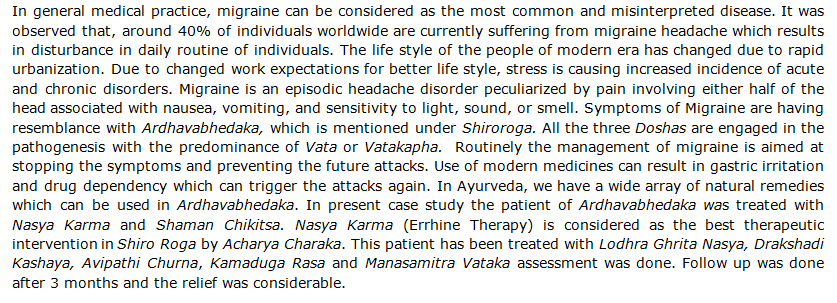Ayurvedic management of Stress Induced Migraine - A Single Case Report
DOI:
https://doi.org/10.21760/jaims.v6i4.1375Keywords:
Ardhavabheda, Lodhra Ghrita Nasya, Shiroroga, Migraine, PranayamaAbstract
In general medical practice, migraine can be considered as the most common and misinterpreted disease. It was observed that, around 40% of individuals worldwide are currently suffering from migraine headache which results in disturbance in daily routine of individuals. The life style of the people of modern era has changed due to rapid urbanization. Due to changed work expectations for better life style, stress is causing increased incidence of acute and chronic disorders. Migraine is an episodic headache disorder peculiarized by pain involving either half of the head associated with nausea, vomiting, and sensitivity to light, sound, or smell. Symptoms of Migraine are having resemblance with Ardhavabhedaka, which is mentioned under Shiroroga. All the three Doshas are engaged in the pathogenesis with the predominance of Vata or Vatakapha. Routinely the management of migraine is aimed at stopping the symptoms and preventing the future attacks. Use of modern medicines can result in gastric irritation and drug dependency which can trigger the attacks again. In Ayurveda, we have a wide array of natural remedies which can be used in Ardhavabhedaka. In present case study the patient of Ardhavabhedaka was treated with Nasya Karma and Shaman Chikitsa. Nasya Karma (Errhine Therapy) is considered as the best therapeutic intervention in Shiro Roga by Acharya Charaka. This patient has been treated with Lodhra Ghrita Nasya, Drakshadi Kashaya, Avipathi Churna, Kamaduga Rasa and Manasamitra Vataka assessment was done. Follow up was done after 3 months and the relief was considerable.
Downloads
References
Silberstein SD. Preventive migraine treatment. Neurol Clin.2009 May; 27 (2):429–43. [PubMed]
Solomon GD, Santanello N. Impact of migraine and migraine therapy on productivity and quality of life.Neurology.2000;55 (9 Suppl 2):S29–35. [PubMed]
Mark W Green, John C.M Burst, Current diagnosis and treatment, Neurology, Headache and facial pain, International Edition, 2008, Mc Graw Hill publications, Singapore, P65.
Hershey AD; Current approaches to the diagnosis and management of pediatric migraine. Lancet Neurology, 2010; 9(2): 190–204.
Nappi RE, Sances G, Detaddei S, Ornati A, Chiovato L, Polatti F; Hormonal management of migraine at menopause. Menopause International, 2009; 15(2): 82–86.
Kasper, Braunwald, Fauci, Hauser, Longo, Jameson. Harrison’s principles of internal medicine, New York: 16thed, 2005; p90.
Acharya Yadavji Trikamaji, N M Acharya, editor. Sushruta Samhita of Sushruta with Nibandhsangraha Commentry of Dalhana Acharya, Uttarsthana. 3rd ed., Ch.25, Ver.15 Varanasi: Chaukhambha SurbharatiPrakashan; 2014. p654
Acharya Yadavji Trikamji, editor. Charak Samhita of Agnivesha with Ayurveda Dipika commentary of Chakrapanidatta, Siddhi Sthana. Ch. 09, Ver.88, Reprint edition. Varanasi: Chaukhambha Prakashan; 2011. p722
Ganesh Krishna Garde, Subhash Ranade Editor(s), (Reprint ed.). Sarth Vagbhat of Vagbhatacharya, Sutrasthana; Nasyavidhim: Chapter 20, Verse 33. Pune: Proficient Publishing House, 2017; p99.
D Sriman Namboothiri. Chikitsa Manjari. Vidyarambham publications. Shiroroga chikitsa shloka 44.
Vaidya Pandit Hariprapannaji, Rasayogsagara vol-I, (Reprint ed.). Kamdudha rasa, Verse 707. Varanasi: Chowkhambha Krish-nadas Academy, 2004; p260.















